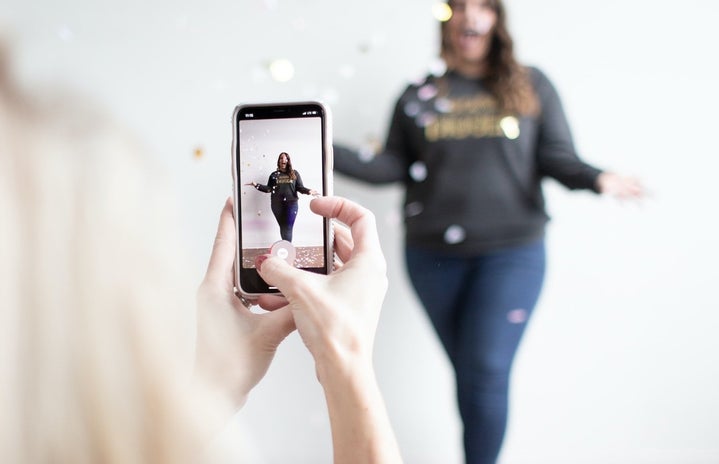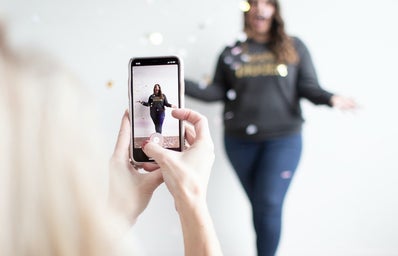TikTok took 2020 by storm. If you’re between the ages of 13-50 — give or take — chances are you’ve encountered the infamous app. You might be an avid user, or TikTok famous. Even entire families have found themselves involved on the ever-expanding social media platform, given that many students are back home because of the ongoing pandemic.
If you aren’t super familiar with the app, here’s a simple run down: it provides endless entertainment. Users can create videos up to one minute in length on whatever they want. Then, TikTok’s ingenious design allows in-app editing to add effects, sounds or text before you post it for everyone to see. You can scroll through these short bursts of entertainment to infinity and beyond (which is why it becomes so addictive). The content covers many areas, including – but not limited to – comedy, makeup, art, cosplay, fashion, cute animals, students and parents alike struggling in lock-down, kids getting their parents to film trends with them, and even people opening up about mental illness. Whatever it is, there’s truly something for everyone. It’s a giant community full of people from all walks of life trying to find connection, creativity and relatable content during these times of isolation and distance.

I was personally uninterested in downloading the app in the beginning, mostly because I didn’t understand it and didn’t feel like I needed to. However, once lock-down struck and I was home, alone and bored, I decided to see what all the fuss was about. I got it pretty quickly. I hopped on the dance trends and learned at least six of them. I got my family involved by challenging them to learn the dances with me. I hopped onto the TikTok coffee trend and the Euphoria trend (if you know, you know). But trends on TikTok last for about a millisecond before they become old news, and people have move onto the next big thing. This fast-paced creative evolution is what really drives to the aspect of truly endless novel entertainment, though – I can’t open the app unless I know I have nothing important to do for at least an hour.
Now, like any social media platform, there are major pros and cons. The biggest con, for me, is how much time I invest into it. Time flies while I’m mindlessly scrolling. Stimulating your mind with too much content at once, staying on too late at night, and witnessing toxic people or toxic behavior can be a negative influence. However, I’m going to highlight something that I haven’t read much on yet: TikTok as an unexpected platform for freedom of expression and identity.
I want to preface this by saying that these are complex topics, and that by no means does TikTok provide this kind of platform for everyone. There are still moments of negativity, cyber bullying, isolation, comparison and hate on the app. Like every other social media platform, it’s not perfect, but it’s been able to provide an outlet different from other popular platforms.
Culture
While using TikTok, I’ve come across people of all different backgrounds sharing pieces of their culture and traditions, such as their clothing, language, music, art and more. I haven’t seen such a diverse range of people represented on a social media app before, even on Instagram (which, to be fair, could be due to Instagram’s mechanism to curate your own content by choosing who you follow – you see only the content you want – or know – to see). Meanwhile on TikTok, you’re mostly viewing the “For You” page, which filters content from people all over the place that you may not necessarily follow, based on videos you like or videos that are trending. You’re always seeing new content from new people, and thus are exposed to different cultures, places, traditions, music, fashion and identities.
In part, the cultural and racial diversity on TikTok may come from people gaining a platform for expression. Suddenly users are seeing more people like them, and thus feel more comfortable sharing parts of their cultural heritage and traditions. There are people from different countries sharing their languages, Deaf people teaching sign language, Native Americans, Indigenous people and First Nations peoples expressing pride for their roots and encouraging others to learn their history, people sharing Chinese street fashion (and dang, it’s really cool)… People are beginning to share forms of cultural expression that I’ve just never come across anywhere else, and I love it.
Identity
Aside from culture, there’s an expansive LGBTQA+ community on TikTok, and whenever I go to read the comments they’re always incredibly supportive and encouraging of one another, which makes me happy to see. Though the LGBTQ+ community may still experience moments of hate and adversity in both their real lives and online, their community on TikTok helps to lift them up, validate their feelings and experiences, and encourage them to continue being their truest selves.
This applies to gender identity as well. This generation is more openly encouraging the use of gender pronouns (she/her, he/him, they/them, she/they, he/they, and more), at least on TikTok. People are respectful of each other’s pronouns and the comment section is generally full of love for people being honest about who they are. It’s like a domino effect: once someone shares their pronouns, tells their coming out story, or shares their personal journey of becoming comfortable and confident in their own skin, it gives other people who might be struggling reassurance and validation. Having good representation and visibility is such a positive influence. The LGBTQ+ community is reigning wide and free on TikTok, and I honestly can’t get enough of the positivity, expression and good vibes that emanate from this “side” of the app. People seem to be playing around much more freely with makeup, fashion, hairstyles, you name it. It’s refreshing to see people tear down all kinds of gender and fashion stereotypes, one TikTok at a time.
Expression
Speaking of breaking down gender stereotypes, there’s a new wave of people fighting against toxic masculinity on the app, and it’s all the rage. Boys in makeup, skirts, crop tops, painting their nails, wearing dresses, and so on. Some of these boys openly identify as straight, while encouraging other boys to wear makeup or nail polish if they want to.
TikTok is serving as a platform where boys (regardless of their sexuality) can feel comfortable enough to wear clothes they might’ve been uncomfortable or scared to wear before. It’s great to wear eyeliner for the first time and have overwhelmingly positive reactions. It’s a step towards allowing men to be themselves rather than forcing harmful masculine stereotypes onto them. TikTok is allowing men to start visualizing that expressing themselves as “less masculine” doesn’t have to be a threat towards their masculinity, because they get to define what masculinity means for them. This seems to be the recent, over-arching theme of TikTok: redefining gender norms.
Unlike Instagram, which promotes a more careful curation of people’s lives that seems too perfect to be real, TikTok is unconfined and unoccupied with curating a perfect image. It serves as a safe space from the toxicity and comparison you might experience scrolling through your Instagram feed. Karli Bendlin, a Byrdie author, wrote, “I can spend hours scrolling through TikTok and not feel an ounce of the sadness or insecurity I sometimes grapple with after going down an Instagram rabbit hole.” TikTok instead treats you to an endless array of short entertaining bursts from random people, often being of an incredibly creative, unexpected, hilarious, unfiltered, relatable, or inspiring nature.
During a time of such isolation, it’s really a community rooting for each other, trying to connect, and surviving this pandemic together in the most genuine way possible. In 2020, there’s no room for unrealistic and overly curated content. We want to see people being honest, which is why Bendlin says, “TikTok is the place where people are beginning to display their realest forms. You get to see the works in progress on TikTok, while people reserve other platforms for the finished product.” So, if you’re looking for a social media app that will make you feel right at home and validate you even in your worst form, TikTok is the place to be.



